Editor's Note: Today we have a guest article from Inna Yatsyna of Serpstat. Inna will be discussing the importance of competitive analysis and how you can use this analysis to improve your site and make it more profitable.
Let's see what she has to say!
Conducting competitive analysis is an important part of any business strategy.
Without knowing your competitors, it’s impossible to understand which of them is the greatest threat, how to defeat them, and where to concentrate your efforts. The companies that conduct competitive analysis and use it to develop a promotion strategy have an advantage over those in the same market who fail to do the same.
Today, being competitive online is more important than ever. Most consumers use the internet to find information about products, services, or companies before making a purchasing decision. Therefore, it’s extremely important to outperform your direct competitors.
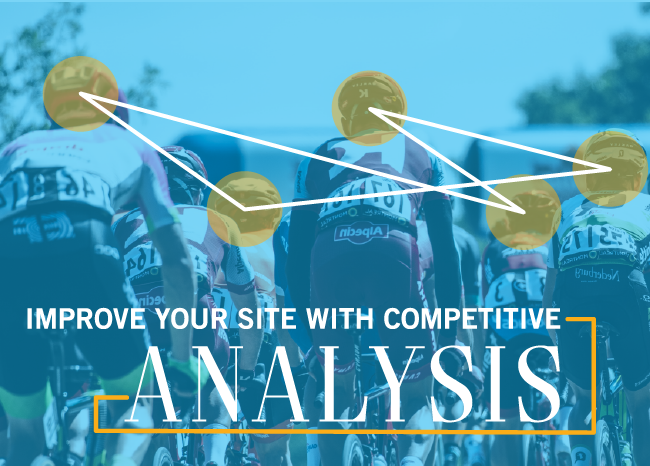
In this post, I’ll show you the best steps for such analysis and explain how you can implement them.
Importance of Competitor Analysis
It’s difficult to overestimate the importance of this analysis. It has a huge number of advantages, and I’ll highlight the most basic ones here:
- Prevent future mistakes by learning from competitors’ mistakes.
- Draw inspiration and ideas from what’s successful for the competition.
- Understand niche trends and learn what works and what doesn’t work.
However, before you can enjoy these advantages, you must properly identify your search competitors.
Finding Search Competitors
Many companies, especially if they are in business for a long time, believe that they know all market players. Such confidence can be dangerous. The market is constantly changing: new companies enter, others diversify, and some go out of business altogether. Therefore, it’s necessary to review your competitors periodically.
You can find them in different ways — from Google search to customer surveys or interviewing your sales department. To save time and collect the most accurate list of your competitors, use specific SEO tools such as Serpstat, SEMrush, Ahrefs.
I’ll go with Serpstat.
Type your site's URL into the search box and get the list of your competitors here:
Website analysis > Domain Analysis > SEO Research > Competitors
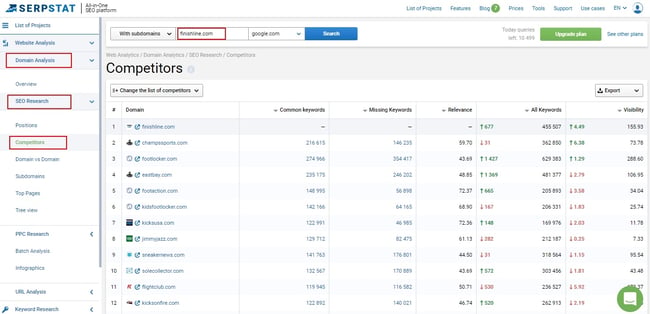
This report shows major organic search competitors, based on the number of common keywords.
Essential Steps in Competitive Analysis
There are five main areas for evaluation in competitive analysis. Understanding each of these areas will help you measure the quality of your site and gain detailed information for future promotion.
- Keyword research.
- Backlink analysis.
- Content and meta tag analysis.
- Structure and usability analysis.
- Traffic sources and speed.
These are the factors that strongly correlate with business goals and should be primary considerations.
Keyword Research
First of all, it’s worth looking at the semantics of your competitors. This information can give you some new ideas for filling gaps in your site’s optimization and content topics.
You can see the list of keywords for all competitors in the same Serpstat report by clicking on their domains. Pay special attention to those competitors who have the most ranking terms and try to understand why they have so many keywords.
Then you should download competitors’ semantics according to where their sites are ranked, but yours isn’t. To do this, go to “Domain vs Domain” in the SEO Research tab and choose competitors’ domains with the biggest keywords list. Then choose unique keywords common to those two competitors and export them to use for your future promotion.
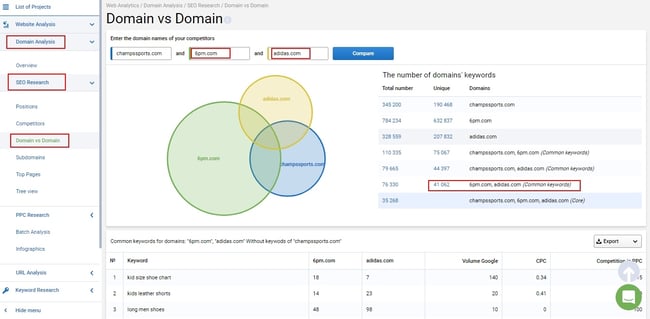
Don’t take every keyword from that list for your resource. Pick only those which are worth targeting — you can check these indexes at Google AdWords.
Backlink Analysis
Search engine optimization, and specifically link building, has evolved from an uninformed mass-purchase of backlinks.
Despite suggestions from some in the industry about Google reducing the impact of backlinks on search visibility, most SEO professionals still prioritize off-page optimization (external backlinks). In many competitive niches, it’s extremely difficult to achieve significant improvements in the performance of your site without a qualitative backlinks profile.
Analyze competitors’ backlinks and then make conclusions about where you should pursue potential link opportunities.
You’ll not be able to analyze competitors’ backlink profiles without using SEO tools.
Ahrefs is great for this purpose. Enter the domain of your competitor in its search box and go to "Backlink profile".
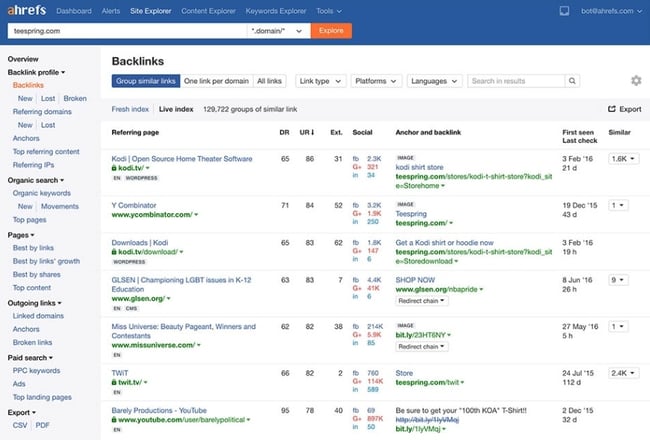
During your analysis, pay close attention to:
- The number and quality of referring web pages and domains.
- Anchor text distribution.
- Regionality of domains.
You’ll likely find relevant link opportunities within your competitors’ backlink profiles, as you share the same audience.
Content and Meta Tags Analysis
One of the more lucrative strategies in content marketing is the analysis of competitor content and creation of better material on the same topic. But how do you analyze competitors’ content? There are several ways.
The quality of content is determined by how fully, objectively, comprehensively, and voluminously a text answers readers’ questions.
Here are some common indicators of content quality:
- Length.
- Grammar.
- Readability.
- Data validity.
- Completeness.
- Interest
- Design.
- Main pages.
- Publications on other sites.
- Activity and popularity in the media.
- Format (text, pictures, video, graphics, audio, infographics, etc.).
- Positions.
To find your competitors’ most popular and best posts, use Buzzsumo. Enter their domain in its search box and study pages that have the biggest number of shares.
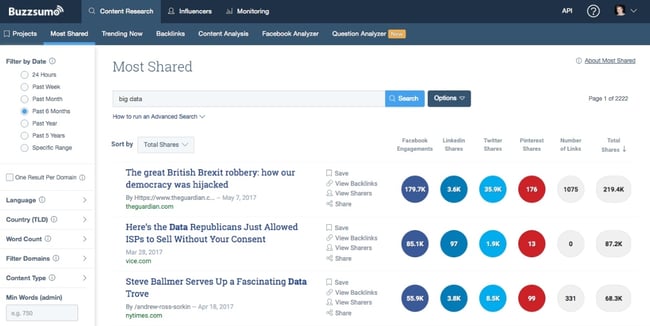
Pay attention to competitors’ meta-information strategy for each page. Every one of them has certain specificity and differs from the others.
You can learn useful tips from this analysis that will guide you as you analyze the content on your own website.
Structure and Usability Analysis
Analyze your competitors’ site structures to get a good idea for some new sections on your site.
Pay particular attention to how your competitors set up the hierarchy of their site and the internal linking structure they use. This will give you an idea of which pages they view as important. Site structure and internal links are used to signal which pages are important to search engines, so it's worth noting which pages competitors are highlighting.
Also, don’t forget to examine readability, key elements position, mobile versions, etc. It’s your chance to collect the best variants of usability and create an ideal site that will earn traffic and income for you.
Sources of Traffic and Loading Speed
Having information about your competitors’ sources of traffic helps you make important conclusions — which channels have potential for you?
You can get this information with the help of SimilarWeb. This service can provide a general picture of competitors’ traffic and divide it into different sources, countries, and so on.
Enter the domain of your competitor in SimilarWeb search box and study the report.
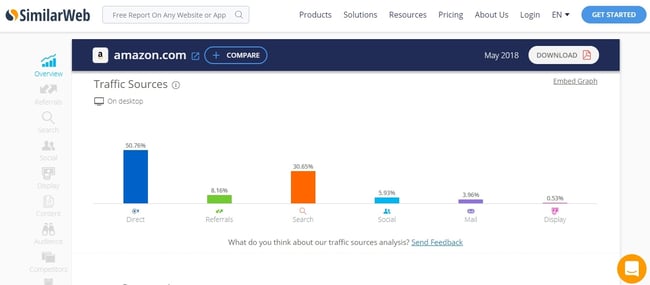
It’s also useful to know your competitors’ loading speed, as you can consider it during the optimization of your future pages. Regardless of competitors’ speed, you should always strive to make your site as fast as possible.
Summary
Competitive analysis should be conducted periodically to determine if your position in the market has changed.
Analyzing competitors empowers you to learn from their mistakes and allocate your budget wisely. Regular analytical work gives you an understanding of how your competitors think, and positions you to counter their tactics.
After reading this post, you know the most important steps in competitive analysis — it’s time to use them to your advantage.

